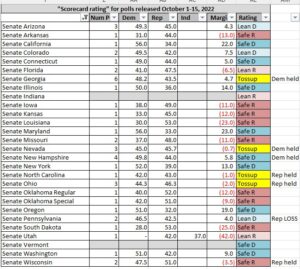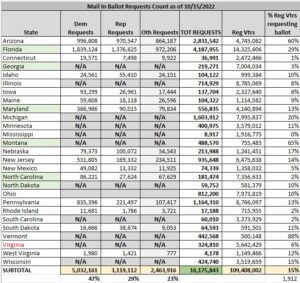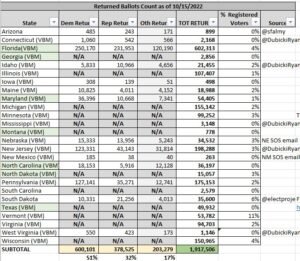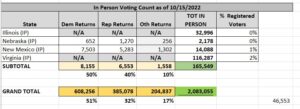America is now in the “3rd Quarter” with the 2022 midterm elections, as individual states are steadily coming online with early voting (early voting in Louisiana begins on October 25 and lasts until November 1). We also have a steady volume of polling that we can use to make assessments on where races are heading – JMC will focus on Senate races today.
Scorecard Criteria
Publicly available polling data for all Senate races has been compiled for October 1-15, and with the availability of polling data for both late August and September (when people DID start to focus on elections), we have some trends that can be determined across the country. As polling data is compiled for a given time period, it is then averaged for each Senate race, and with the average poll showing for each candidate, here’s how JMC rates each race:
(1) Safe Democratic/Republican – A candidate either has a polling average of at least 50% and/or at least a 10-point lead in the polls;
(2) Lean Democratic/Republican – A candidate has a 3–9-point lead in the polls;
(3) Tossup – A candidate’s lead is less than 3 points in the polls;
JMC’s 10/16 Scorecard
Given those criteria, this is the “state of the US Senate” as of the writing of this article (and based on October 1-15 polling data consisting of 45 individual Senate race polls):
Aggregate Dashboard statistics
- Biden job approval: 54-44% Disapprove (was 54-43% disapprove)
- Congressional job approval: 62-25% Disapprove (was 59-22% disapprove)
- Generic congressional vote: 46.5-45.5% Republican/Democratic (was 45-45% Democratic)
- Direction of country: 68-28% wrong direction (was 65-29% wrong direction)
Senate race statistics
- Current: 50 Democrats, 50 Republicans
- Polling average: 49 Democrats, 47 Republicans, 4 Tossups (2 Republican seats, 2 Democratic seats) (was 49-48 Democratic in previous analysis)
- Net pickup: +1 Democratic (was +0 net gain in previous analysis)
Commentary: Since the previous scorecard, there have been two ratings changes, and those changes marginally benefit the Democrats:
- Nevada Senate: from “Leans Republican” to “Tossup”– while Democratic Senator Catherine Cortez-Masto has seen a steady erosion in her support from 46-44 in late August to trailing her Republican challenger 43-47% in the last scorecard, she now trails only 45-46%. Therefore, we’re moving back to TOSSUP;
- Wisconsin Senate: from “Leans Republican” to “Safe Republican” – in late August, Republican incumbent Ron Johnson trailed his Democratic challenger 46-50%. Since then, his showing has steadily improved. Even allowing for the fact that Wisconsin is a marginal state politically, he now has a 51-47% lead in the average of polls conducted this month;
- There have been only two polls conducted in Pennsylvania (an open Republican seat) this month. But Dr Oz seems to be holding at a 4-point poll deficit (43-47%). Which does not meet the criteria to be reclassed to a “tossup” race, but it’s close to that classification;
- While Arizona’s Senate race remains “leans Democratic”, the margin by which Democratic incumbent Mark Kelly is ahead has fluctuated between 4 and 6 points. In the last two weeks, it was back down to +4 for Senator Kelly. Which, like Pennsylvania, is just outside of the 3-point margin we’d need to reclassify this race as a tossup;
- In Ohio (an open Republican seat), the Republican candidate has for the first time seen leads in recent polls, but is lead has not been consistently at +3 or more, so we’re keeping our “Tossup” rating for now;
- Similarly, in New Hampshire, Democratic Senator Maggie Hassan has seen her lead drop from +9 to +6%. Here, a little context is appropriate: New Hampshire had a late (September 13) primary, so this race has been a “late bloomer.” Still, with New Hampshire being a highly elastic state with minimal early voting, movement towards the +/- 3% range makes this race worth paying attention to;
- Finally, Herschel Walker (the Republican nominee in the Georgia U.S. Senate race) has had a very challenging two weeks, but given that polls only moved a few points against him as a result, we’re not yet convinced he’s permanently damaged, so we’re keeping this race as a tossup. Especially since Georgia requires a runoff if neither candidate gets 50% on Election Day – and there are also two third party candidates on the ballot.
Bottom line: with up to 7 potentially volatile Senate races, there is still a lot up in the air. And time is running out, as early voting is steadily “coming online.”
Early voting
While Election Day isn’t until November 8, in person early voting has already started in 16 states, and will commence in 9 more states this upcoming week. As of the writing of this article, here’s where we stand both with mail ballot requests, actual voted mail ballots, and in person early voting:
- Mail ballot requests : 16,175,843 (was 217,094 a month ago)
- Returned mail ballots: 1,917,506 (was 943 a month ago)
- In Person Early Votes: 165,549 (was 43,418 two weeks ago)
(In other words, nearly 2.1M have already voted (early voting in Louisiana commences on Tuesday, October 25))
Why do these early voting numbers matter ? As mentioned in this analysis, 72% of the vote was cast before Election Day, and even considering that some of that was caused by the pandemic’s changing voting behavior (whether voluntarily or by government decree), JMC believes that there has been a permanent shift to some extent of people wanting to “get it over with” and vote before Election Day. This mindset WILL affect when people are making up their mind about who to vote for, and both candidates/consultants would be wise to take this new paradigm into consideration when planning their messaging/get out the vote efforts.
Conclusion
Movement in Senate races has been slow. But now that we’re in the final stretch, and early voting is heating up, the poll numbers (and the trend) REALLY start to matter.




